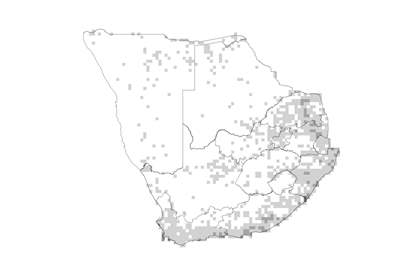 |
 Species distribution and density. Darker squares represent higher density of members of this family. |
Introduction
Spike-thorn family
A family of trees or shrubs, rarely climbers, unarmed or with thorns (modified axillary shoots), some with latex in the leaves and bark, evident as elastic threads on breaking parts, and often with a yellow powdery pigment present on exposed bark. Flowers have pronounced floral discs, which develop into characteristic capsules or drupes, and in many species, seeds have fleshy arils.
Distribution
Found in tropical and subtropical regions and extending into warmer temperate regions. In southern Africa higher levels of diversity are found in the eastern half of the region.
Number of genera in the world
ca. 109
Number of species in the world
ca. 1 300
Number of genera in the Flora of southern Africa region
24
Number of species in the Flora of southern Africa region
92
Well-known southern African genera
Cassine, Catha, Elaeodendron, Gymnosporia, Hippocratea, Maytenus, Mystroxylon, Pterocelastrus, Putterlickia, Salacia
Growth forms
Trees, woody shrubs, climbers and rarely suffrutices (dwarf shrubs).
Habitats
Very variable in habitat choice including savanna, thicket, forest, grassland, coastal scrub areas and even desert.
Flagship species
Gymnosporia buxifolia (common spike thorn; gewone pendoring [A]; uBangalala [Z]) is a thorny and very variable shrub or small tree that is widely distributed in southern Africa. It is distinguished by its small, round and rough fruit. In botanical literature it is frequently and wrongly referred to as Maytenus heterophylla. This plant produces very hard and strong wood that may be used for the making of tool handles, and for engraving and turnery. (Photo: GN).
Significance of the family
The family has a wide range of medicinal applications. Extracts from some species are used as insecticides. Many species have edible fruit and seeds. Oil is derived from seeds of some species. The wood is used for timber; stems for basket weaving and bark for arrow poison. Catha edulis is used as a stimulant and chewed or drank as a tea. *Celastrus and *Euonymus are popular ornamentals. The bark, young leaves and thorns of, e.g. Gymnosporia and Cassine species, are browsed by game and cattle. Birds relish the fruit of species with fleshy arils. (Photo: GN).
Diagnostic characters
Woody plants; branches often angular . Leaves alternate, clustered or opposite; stipules very small. Flowers small and regular , white, pale yellow or green, sometimes red. Petals 5, free. Stamens 5, free �, arising from a disc. Ovary superior , but partly sunk into flower disc � which is fleshy and nectar-secreting. Style short, 2- or 3-lobed. Fruit a capsule, flattened dehiscent mericarps or a drupe . Seeds often winged or enclosed in coloured aril �, or without an aril. (Photo : GN).
Did you know?
*Salacia oblonga and *S. reticulata from India and Sri Lanka are used in the prevention and treatment of type two diabetes and obesity.